We all create rubbish, and it’s easy to feel overwhelmed by the amount piling up in landfills. This waste pollutes our environment and squanders valuable resources. The good news is that there are simple, eco-friendly ways to manage our waste that make a significant, positive impact.
The most effective eco-friendly ways to handle rubbish go beyond just sorting plastics. The best methods include reducing what you buy, reusing items, recycling materials like paper and glass, and composting organic waste. Donating old goods and choosing products with minimal or recycled packaging are also vital. These actions conserve resources, save energy, and reduce the burden on our landfills, helping to build a circular economy.
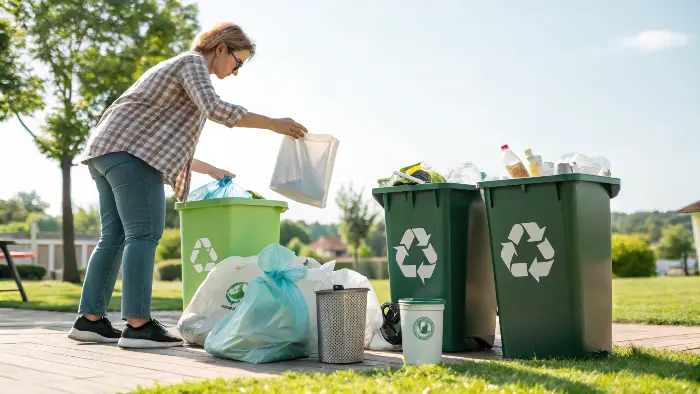
This all sounds good in theory, but how does it actually work in practice? It can feel like a lot to take on. Let’s break down these methods one by one. By understanding how each step works, you can easily start making changes in your business or daily life. It all begins with understanding why these actions are so important in the first place.
How is recycling eco-friendly?
You carefully separate your paper, plastic, and glass, but do you ever wonder if it really makes a difference? It’s easy to feel like your small efforts get lost in the face of global waste challenges. The truth is, recycling has a massive and direct positive impact on our planet.
Recycling is eco-friendly because it conserves precious natural resources like timber, water, and minerals. It saves a huge amount of energy compared to making new products from raw materials. This energy saving also reduces greenhouse gas emissions that cause climate change. It also keeps waste out of landfills and oceans, protecting wildlife and ecosystems from pollution.
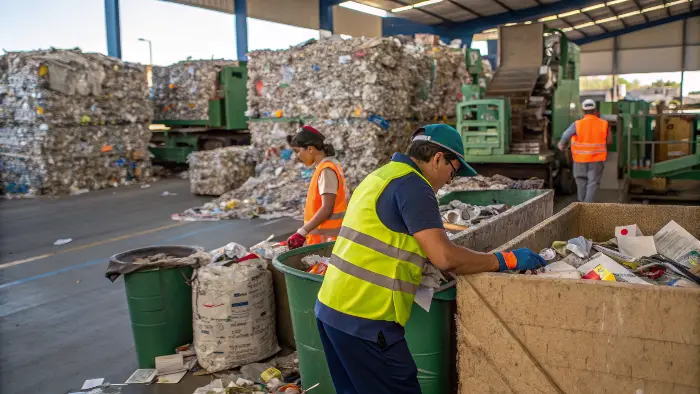
Let’s dive deeper into the specific benefits. When I first started Ecosourcecn, my goal was to provide sustainable alternatives. But to do that, I needed to understand the fundamental "why" behind it all. The environmental case for recycling is incredibly strong and rests on three main pillars.
1. It Conserves Our Natural Resources
Every product we use comes from somewhere. Paper comes from trees, glass from sand, and plastic from oil. When we throw these items away, we are essentially throwing away the raw materials they are made from. Recycling breaks this linear "take-make-waste" model. For example:
- Paper: Recycling one ton of paper can save 17 mature trees, thousands of gallons of water, and a significant amount of energy.
- Aluminum: Recycling aluminum is a huge win. It uses about 95% less energy than producing it from bauxite ore, a process that involves destructive strip-mining.
- Glass: Glass can be recycled endlessly without any loss in quality. This reduces the need to quarry for more sand and other minerals.
By turning old products back into new ones, we reduce the need to extract more resources from the earth, preserving forests, landscapes, and biodiversity for the future.
2. It Saves Energy and Fights Climate Change
Manufacturing products from recycled materials almost always uses less energy than making them from scratch. This is one of the most significant environmental benefits. Think about the energy needed to mine ore, ship it, refine it, and process it into a final product. Recycling skips many of these energy-intensive steps. This energy saving directly translates to a lower carbon footprint because most of our energy still comes from burning fossil fuels. Every can, bottle, and newspaper you recycle helps reduce the greenhouse gas emissions warming our planet.
3. It Protects Our Ecosystems
When we don’t recycle, where does our rubbish go? Most of it ends up in landfills or, worse, in our oceans. Landfills are a major source of methane, a potent greenhouse gas. They can also leak toxic liquid, known as leachate, which can contaminate soil and groundwater. Plastic waste that finds its way into rivers and oceans harms and kills marine life. I’ve seen this firsthand on trips abroad, where beautiful coastlines were spoiled by plastic debris. It was a powerful reminder that "away" doesn’t exist. Recycling diverts tons of waste from these harmful destinations, keeping our land and water cleaner and safer.
What are the 4 ways to recycle waste?
The word "recycling" often just makes us think about the different bins for paper and plastic. This narrow view can make us miss bigger and more impactful opportunities to reduce our environmental footprint. A much better way to think about it is a broader framework that offers a more powerful approach to waste.
The four key ways to handle waste are Reduce, Reuse, Recycle, and Rot (Compost). This is a hierarchy that prioritizes preventing waste in the first place (Reduce, Reuse) before managing what is left (Recycle, Rot). Reducing consumption, reusing containers, recycling materials, and composting food scraps form a complete strategy for minimizing your environmental impact.
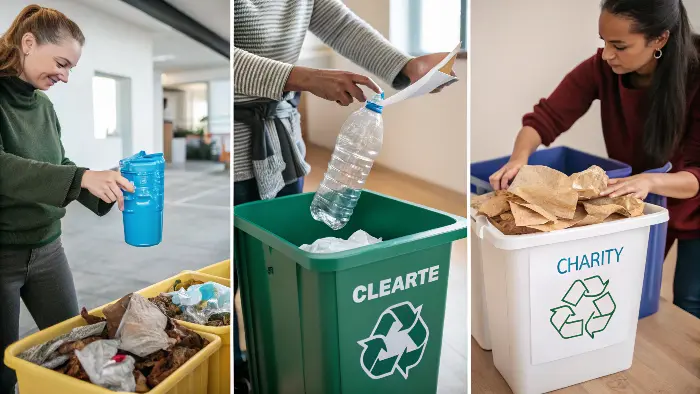
This "4 R’s" model is the foundation of a truly sustainable lifestyle. It shifts our focus from simply managing waste to preventing it from being created. As a supplier of eco-friendly products, I always advise my clients, like Jacky in Canada, to think in this order. It’s not just about finding a compostable cup; it’s about asking if a reusable cup could be used first. Let’s explore each of these steps.
The 4 R’s Explained
| Principle | Action | Examples |
|---|---|---|
| Reduce | Use less stuff. | Buying in bulk, saying no to plastic bags, going paperless with bills, avoiding single-use items. |
| Reuse | Use items again. | Using a reusable water bottle, donating old clothes, repairing broken items, using glass jars for storage. |
| Recycle | Remake into new items. | Sorting paper, plastic, glass, and metal for curbside collection or drop-off centers. |
| Rot | Compost organic matter. | Putting fruit and vegetable scraps, coffee grounds, and yard waste into a compost bin. |
Reduce is the most important "R." The best way to manage waste is to not create it at all. This means being a more conscious consumer. Before you buy something, ask yourself if you really need it. Can you buy a version with less packaging? This is a core part of our mission at Ecosourcecn—we help businesses find packaging that is minimal yet effective.
Reuse is the next best thing. It’s about extending the life of an item. This can be as simple as using a reusable shopping bag or coffee cup. It also includes repairing things instead of replacing them and donating items you no longer need so someone else can use them. This keeps valuable resources in circulation and out of the landfill.
Recycle is what most people are familiar with. This is the process of collecting and processing materials that would otherwise be thrown away as trash and turning them into new products. It’s a crucial step for materials like aluminum, paper, and certain plastics that can be effectively remanufactured.
Rot, or composting, is nature’s way of recycling. It’s for all the organic stuff, like food scraps and yard trimmings. Instead of letting this waste rot in a landfill and produce methane, composting turns it into nutrient-rich soil that can be used to grow more food.
What is an eco-friendly method of disposing of garbage?
Even after we reduce, reuse, and recycle, we are sometimes left with "garbage." Tossing it in the bin can feel like a failure, as we know it’s heading straight for a landfill. But there are specialized, eco-friendly disposal methods for items that don’t fit into the typical recycling categories.
An eco-friendly disposal method is any process that diverts waste from the landfill. Composting is a perfect example for organic waste, turning food scraps into valuable soil. For other items, donation and repurposing give products a new life. For hazardous materials like batteries or electronics, specialized e-waste recycling ensures toxic components are handled safely.
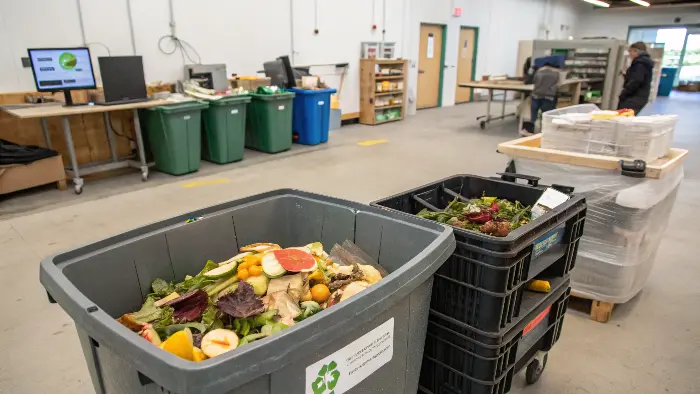
Thinking beyond the standard recycling bin is key to advanced waste management. It requires us to identify the specific type of waste we have and find the correct disposal path for it. This is where we can make a huge difference for those hard-to-recycle items.
1. The Power of Composting
I mentioned composting as the fourth "R," but it deserves a closer look as a disposal method. When organic waste like food scraps goes to a landfill, it gets buried. Without oxygen, it decomposes anaerobically, producing methane, a greenhouse gas over 25 times more potent than carbon dioxide. Composting, on the other hand, is an aerobic process. With plenty of oxygen, microorganisms break down the organic matter into a stable, nutrient-rich material called humus. This is why we champion compostable products made from materials like PLA and bagasse. When disposed of in an industrial composting facility, they break down completely, returning nutrients to the soil without producing harmful methane.
2. Donation, Upcycling, and Repurposing
Before you label something as "garbage," ask if it could have another life.
- Donation: Clothes, furniture, books, and tools that are still in good condition can be donated to charities. This is a powerful form of reuse that benefits your community.
- Upcycling: This is a creative form of reuse where you transform waste materials into new products of higher quality or value. Think of turning old wooden pallets into a coffee table or cutting glass bottles into drinking glasses.
- Repurposing: This means using an item for a different purpose than its original one. Old jars become storage containers, and old t-shirts become cleaning rags.
3. Handling Hazardous and Electronic Waste (E-Waste)
Some items should never go in your regular trash bin because they contain toxic materials. These include:
- Batteries: Contain heavy metals like lead, mercury, and cadmium.
- Electronics: Contain lead, mercury, and flame retardants.
- Paints, solvents, and cleaners: Contain harmful chemicals.
- Light bulbs: Fluorescent bulbs contain mercury.
Most communities have designated drop-off locations or special collection days for this type of hazardous waste. Proper disposal ensures that these toxic substances don’t leach into our soil and water, and it allows for the recovery of valuable materials from e-waste.
How to dispose of waste eco-friendly?
Knowing all the different methods is one thing, but putting them into practice every day is the real challenge. It can feel overwhelming to change old habits and try to make the right choice for every single piece of waste. The key is to build a simple, conscious system for yourself.
To dispose of waste eco-friendly, start by being a conscious consumer. Choose products made from recycled materials or with minimal, compostable packaging. Set up an organized sorting system in your home or office with separate bins for recycling, compost, and landfill. Regularly donate usable items you no longer need. This proactive approach is the most effective way to minimize waste.
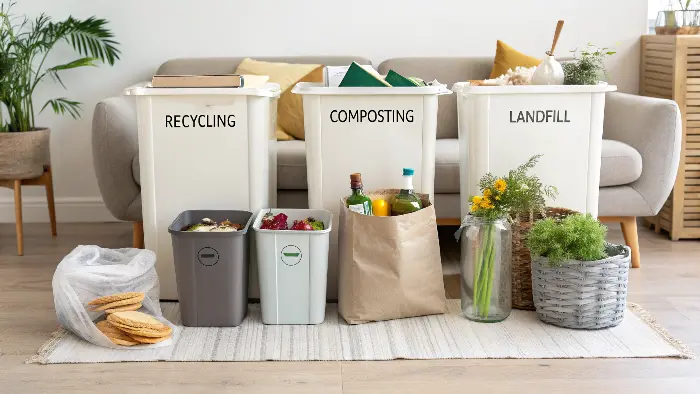
Ultimately, disposing of waste eco-friendly is less about the final act of disposal and more about the choices you make long before something becomes waste. It’s a lifestyle shift. Here are some practical ways to build this system into your life.
1. Be a Conscious Consumer
Your power starts at the store. Every dollar you spend is a vote for the kind of products you want to see in the world.
- Choose Recycled Content: Look for products and packaging made from post-consumer recycled materials. This creates a market for the items you put in your recycling bin.
- Demand Better Packaging: Support brands that use minimal packaging or innovative materials like our compostable bagasse containers. Avoid products with excessive layers of plastic.
- Buy to Last: Invest in high-quality, durable items that you can repair instead of cheap, disposable ones. This follows the "Reduce" and "Reuse" principles.
When I work with clients, I emphasize that their sourcing decisions have a ripple effect. By choosing certified sustainable products, they are not just improving their own brand’s footprint; they are supporting a global supply chain that values environmental responsibility.
2. Set Up Your Home or Business for Success
Make it easy to do the right thing. A clear and simple sorting system is essential. You don’t need anything fancy, just clearly labeled bins.
| Bin Type | What Goes Inside | Why It’s Important |
|---|---|---|
| Recycling | Clean paper, cardboard, glass bottles, aluminum cans, specific plastics (check local rules). | Recovers valuable materials and saves energy. |
| Compost | Fruit/vegetable scraps, coffee grounds, eggshells, yard trimmings, certified compostable products. | Creates nutrient-rich soil and avoids landfill methane. |
| Donation Box | Clothes, books, electronics, and household items that are still usable. | Gives items a second life and supports your community. |
| Landfill | Items that cannot be recycled, composted, or reused (e.g., chip bags, broken ceramics, styrofoam). | This should be your last resort and smallest bin. |
3. Look Beyond Your Own Bin
Individual actions are powerful, but they become even more so when they are part of a larger community effort. Support businesses that have take-back programs for their products or packaging. Advocate for better and more accessible recycling and composting services in your city. Participate in or organize local clean-up events. By working together, we can create systems that make eco-friendly disposal the default, not the exception.
Conclusion
Eco-friendly waste disposal is about a fundamental mindset shift. It’s about moving away from a "throwaway" culture to one that sees waste as a resource. By actively practicing the principles of Reduce, Reuse, Recycle, and Rot, we can all contribute to a healthier planet and a more sustainable future.


